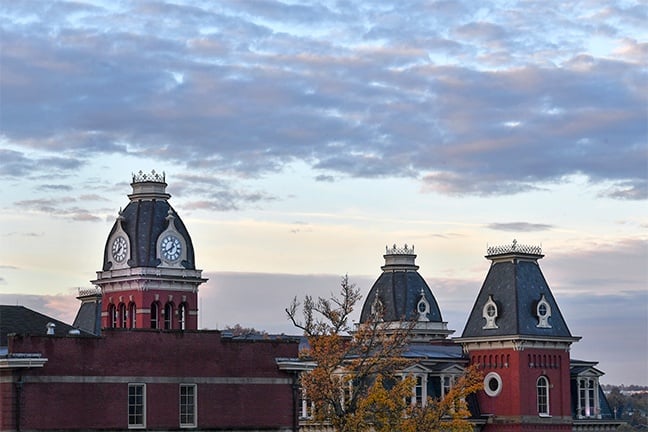
It's no secret that West Virginia has some of the highest rates of obesity and cardiovascular disease in the country. But to create a healthier landscape in some of our state’s unhealthiest counties, a few West Virginia University faculty believe you have to empower the entire community.
Communities in WV's Clay and McDowell counties will soon be the focus of a rural health project led by faculty from WVU Extension Service, WVU College of Physical Activity and Sport Sciences, and WVU School of Public Health and West Virginia Prevention Research Center, who received a five-year grant from the Centers for Disease Control and Prevention to help reduce obesity and other chronic diseases in these communities related to long-term unhealthy lifestyles.
By involving the communities and building partnerships among community leaders, the team will work to improve access to healthy food and create more opportunities for residents to be more physically active.
“Right now, there aren’t a lot of options when it comes to eating healthy and being active in rural West Virginia. But, I believe education and access to these things can change our residents’ attitudes,” said Michael Shamblin, WVU Extension Service agent and associate professor in Clay County. “We’re looking to develop a community atmosphere that inspires healthier lifestyles.”
First on the project’s to-do list is developing community coalitions to help guide WVU’s interdisciplinary team and determine what each community actually needs, creating a well-rounded action plan to enhance residents’ quality of life.
Emily Murphy, WVU Extension Service childhood obesity prevention specialist and associate professor, believes that involving the community in each step is the only way to create success and sustainability.
“While we know the focus of the project has to be on increasing physical activity and healthy eating, I can’t decide what will work best for these communities. They need to have a voice in this because they know what their community members are willing to do – what they will get behind,” Murphy said. “It takes a while to build these important relationships, but working together, we will develop a feasible, customized plan of action for each community.”
The project, appropriately called, Be Wild, Be Wonderful, Be Healthy, is not designed to just tell the residents of Clay and McDowell counties to be healthier, it teaches and encourages each person to take ownership of their health and their community’s health.
“As a primary risk factor for a number of chronic degenerative diseases, physical inactivity and poor nutrition represent a serious public health concern in West Virginia,” said Sean Bulger, a professor from the WVU College of Physical Activity and Sport Sciences. “We expect to facilitate people’s progress toward the achievement of health-enhancing amounts of physical activity through the use of evidence-based strategies.”
In addition to the coalitions, community members and organizations can get further involved by applying for a series of mini grants available each year for the duration of the project and participating in sustainability training. Both of which are designed to allow the community to drive the success of the project.
The Be Wild, Be Wonderful, Be Healthy project follows right on the heels of another successful collaboration with the CDC, the West Virginia Healthy Children Project, aimed at promoting active, healthy lifestyles among West Virginians in Barbour, Gilmer and Pleasants counties, but one that was specifically geared toward our state’s youngest residents and their families.
Though the projects and their goals differ, the Be Wild, Be Wonderful, Be Healthy project will use a similar mini-grant model to put the money back into the community and help Clay and McDowell residents create healthier futures.
“We do not see this as just a project. This opportunity is designed to promote true change in Clay and McDowell counties,” said Nancy Tompkins, a research assistant professor from the WVU School of Public Health and co-investigator of the West Virginia Prevention Research Center. “Projects come and go, but a focus on improving policies, systems and environments enables sustainable, community-wide change.”
Note: This article was originally published by Hannah Booth on October 19, 2018 here.
What is a land-grant university?
The history of land-grant universities goes all the way back to Civil War-era America. In 1862, the U.S. Congress passed and President Abraham Lincoln signed the first Land-Grant Act (also known as the Morrill Act for its sponsor, Rep. Justin Morrill of Vermont).
The purpose of the Land-Grant Act was “the endowment, support, and maintenance of at least one college where the leading object shall be, without excluding other scientific and classical studies and including military tactics, to teach such branches of learning as are related to agriculture and the mechanic arts, in such manner as the legislatures of the States may respectively prescribe, in order to promote the liberal and practical education of the industrial classes in the several pursuits and professions in life.”
In other words, the legislation reflected a growing demand for agricultural and technical education in the United States. At a time when higher education was still widely unavailable to many agricultural and industrial workers, the Morrill Act opened the opportunity of a practical education to a broader segment of the population.
Because of their land, funding, and mission, these universities remain a unique place for graduate students to participate in world-class research and local service to the community.
Since West Virginia University was founded in 1867, it has remained dedicated to its land-grant commission of promoting access to higher education and applying research to meet the needs of West Virginians. The land-grant mission is at the core of WVU’s identity as a university, from the Extension Service and Engineering to Public History and Health Sciences.
If you're interested in getting a degree in public health or pursuing another degree that will enable you to actively make real, tangible differences in the world around you, we encourage you to contact us and to find out how you can join the fight in making our world a better place.
Explore our newest interactive resource — Impacting Social Change in the Field of Public Health!









